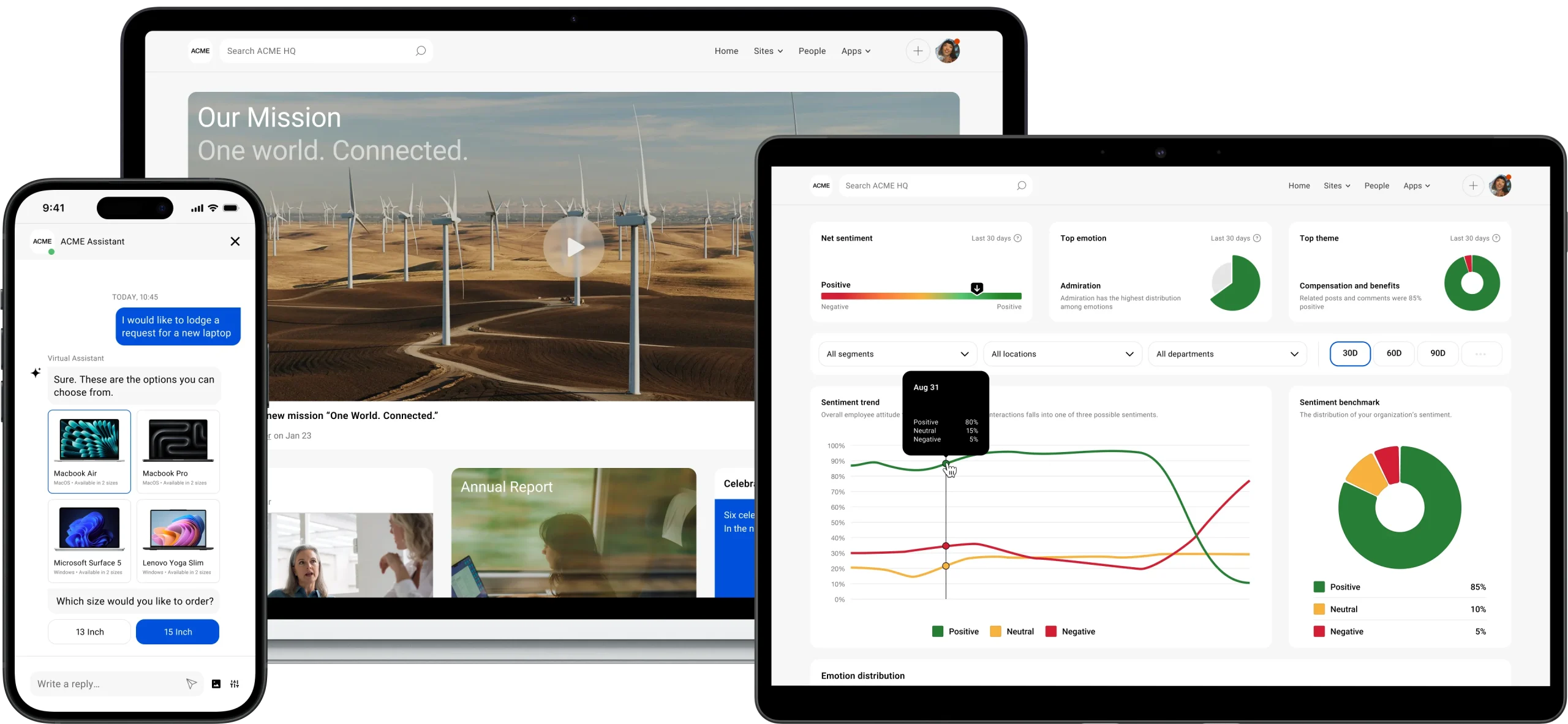In any organization's ecosystem, internal communications is vital to fueling connection and engagement. Yet even the most finely tuned communication strategies can lose their edge if not regularly reviewed and refined.

How to do an internal communications audit
- 1 What is an internal communications audit?
- 2 Why conduct an internal communications audit?
- 3 When to conduct an internal communications audit
- 4 Internal communications audit questions to ask employees
- 5 Internal communications audit planning checklist
- 6 How to conduct an internal communications audit: a step-by-step guide
- 7 Challenges in conducting an internal communications audit
- 8 Regularly conduct internal communication audits
- 9 How Simpplr can help
When was the last time your company conducted an internal communication audit? If you aren’t sure, it’s time to do an internal communications audit.
What is an internal communications audit?
An internal communications audit is a process designed to evaluate and enhance the effectiveness of corporate communications. The aim of an internal communications audit is to identify strengths and weaknesses while uncovering gaps and redundancies.
An audit helps understand how communication can be improved to better align with organizational goals. It involves reviewing existing communication strategies, channels, and internal communication tools.

Why conduct an internal communications audit?
Conducting an internal communications audit provides several key benefits:
- Enhanced clarity: Streamlines communication processes to ensure messages are clear, consistent, and easily understood by all employees
- Improved engagement: Boosts employee engagement by addressing communication barriers and ensuring employees feel informed and valued
- Alignment with goals: Ensures that all communications align with the organization’s strategic objectives, fostering a unified direction and purpose
- Identify effective communication channels: Uncovers redundant or ineffective communication practices, allowing for more focus on channels that maximize impact
- Employee feedback integration: Provides a platform for employees to voice their communication needs and preferences, leading to a more tailored and effective communication strategy
- Informed decision-making: Provides data-driven insights that support strategic decision-making in communication planning
How often should you conduct an internal communications audit?
Communication audits are best done quarterly to keep your finger on the pulse of employee sentiment. It’s essential not to wait longer than six months, or it might become a time-consuming task of little real-time value. It may also be beneficial to conduct an audit after significant organizational changes or events.
Ask yourself the following questions:
- Is the company adjusting to a new process, like hybrid or remote working?
- Have there been recent mergers or acquisitions requiring newly aligned communications strategies and technology?
- Is communication consistent in tone, transparency, and frequency?
- Do any of your company’s communication channels need to be reorganized?
The answers to these questions can give you a better picture of the frequency and scope of your next internal communications audit.
When to conduct an internal communications audit
While you’re defining the reason for an upcoming audit, watch out for the following warning signs that indicate a change may be necessary:
- Workers aren’t receiving necessary communications. Corporate communications must align with the company mission and objectives, which is often designed for desk-based employees. If your workforce is on the front line or in transit, your communications might not hit home. Ask yourself whether off-site employees receive relevant information when and how they need it.
- Your communications aren’t capturing attention. If processes don’t change or develop as expected, your communications might not be adequately absorbed as intended. Remember, communication isn’t merely sending a message. If that message isn’t read and understood, no true communication has taken place.
- Employees are disengaged from content. Employees who aren’t engaging with their company’s communication efforts could be bored with old content or spammed with too much of it. People and companies constantly change, so it helps to be proactive when designing an effective program.
- Information isn’t being widely shared. Different departments may have a silo mentality. The tendency to not share information with other teams or individuals creates a bottleneck in any company’s communication efforts. This can make employees feel excluded, which fosters an atmosphere of distrust.
Internal communications audit questions to ask employees
While you are compiling the questions to ask during your audit, here are a few not to be missed. Find out what employees actually want to read about, hear, and see. Be prepared for a wide variety of responses.
- Are you getting the communication you need, and does it arrive at the right time? This is about critical information and timing. A frontline worker doesn’t want to know their shift has been canceled after a one-hour commute in bad weather.
- How would you rate the communication you currently receive? This is a chance to gauge the quality of content you send and its general or specific relevance.
- How do you prefer to receive notifications? Ask all employees — remote, hybrid, frontline, and those who travel frequently — how best to ensure they receive their communications. Some will want email or direct messaging, while others will check the intranet. Information sent via the wrong channel might not be read at all.
- How easily can you find the information you’re looking for? Find out if people are struggling to access needed information. We’ve all been on user-unfriendly sites where we simply don’t know what’s happening. Make sure your information is easily accessible to all users.
- What information interests you the most? Give participants a chance to tell you what they like about your current content, plus what they would love more of in the future.
- How would you rate our current company communications? This can be a difficult question to ask. The audit is a collaborative exercise toward the greater good, so don’t take anything personally.
- How can we improve our comms strategy moving forward? This question should result in a large quantity of data. While it’s never possible to implement every suggestion, consider all input so employees feel their contributions are worthwhile.
- What’s your opinion on communications from leadership? This is an important one. Employees need transparent and trustworthy communication from managers. Make sure to get buy-in from the top on soliciting this kind of feedback.
- Are you aware of company goals and how your work contributes to them? This is your chance to see how communications have positively or negatively affected employee engagement. An excellent communication strategy enhances a sense of inclusion and increases engagement.
- What would you like to see or hear less of? It’s worth remembering we’re all different. What’s fascinating or necessary to one person will go unnoticed by another. Embrace the input and move forward.

Internal communications audit planning checklist
A thorough preplanning phase is essential for a successful internal communications audit. Use the following checklist to ensure you are well prepared:
1. Get leadership buy-in and engage key stakeholders
Secure leadership buy-in to ensure the audit aligns with broader organizational goals. Identify key stakeholders who will be involved in or affected by the audit, such as senior leaders, people managers, and communication teams.
2. Gather existing data and resources
Compile existing communications materials relevant to the audit, such as newsletters, emails, intranet content, and meeting notes. Review any previous audit reports or assessments to understand past challenges and improvements already made.
3. Establish a timeline and milestones
Develop a realistic timeline for the audit process, including key milestones and deadlines for each phase. Allocate time for preparation, data collection, analysis, and reporting, ensuring alignment with organizational priorities and schedules.
4. Select and prepare tools and methodologies
Decide on the audit methodologies, such as employee pulse surveys, focus groups, or interviews. Select tools or platforms to facilitate data collection and analysis. Ensure that these tools are accessible and user-friendly for participants and align with your data collection needs.

How to conduct an internal communications audit: a step-by-step guide
1. Define the scope and objectives
Clearly outline the goals of the internal communications audit. Determine what specific aspects of internal communications you intend to evaluate, such as channels, message effectiveness, employee engagement, or information flow.
Identify the scope of the communications audit. Are you going to look at a specific department or team? Or will the audit be conducted organizationwide? Are you evaluating the effectiveness of current channels or looking to understand what other channels to add?
2. Gather feedback
The best way to kick off a communications audit is by conducting interviews, surveys, and roundtable discussions. You’ll get valuable feedback data from these processes. Be sure to include communications data from any communications technology or intranet in use.
For on-site employees, roundtable sessions are a great way to collaborate and build connections. Many interesting and relevant things will surface by encouraging open dialogue. Don’t forget your remote and frontline workers. Include them by using digital surveys and virtual meetings.

You’ll get a better level of feedback on surveys if these can be completed anonymously. In group meetings, mix things up a bit. Separate managers and their teams so no one has to answer questions beneath the gaze of their supervisor or direct reports. For the same reason, face-to-face interviews are usually better when done by a neutral party.
Look at metrics from your current communications channels to see what’s working and where improvements are needed. Check email rates, direct messaging feedback, internal blog traffic records, and companywide online meeting attendance lists.
3. Maintain an open mind and stay focused on objectives
Surveys, interviews, and group sessions will give you an idea of your current company culture and what is or isn’t working from a communications standpoint.
Throughout the process, it’s essential to put aside established mindsets. Everyone faces a unique set of challenges, so it’s normal if your communications efforts aren’t generating 100% response throughout the organization.
Some people will appreciate your efforts but choose not to get involved beyond what is absolutely necessary for their day-to-day work. Keep in mind that the point of the audit is to evaluate and improve internal communications for all employees as much as possible. You won’t always make everyone happy, but you can make them aware.
4. Analyze and share communication audit findings
Once the research is done, it’s time to analyze the data and present the findings. Share your report with leadership and employees. They are more likely to read a report that is clear, concise, and engaging.
For leadership, it’s a good idea to present benchmarking data to identify and consider competitive trends. Their time is tight, so be concise. Looking at other companies’ communications can also highlight areas for improvement.
Encourage input to identify weak spots or gaps and where to implement required improvements. Ask leaders for any support or technology needed. Raise any relevant issues that might have come up in the group discussions and make recommendations where possible.
If the report leads to strategic changes, be sure to share decisions with employees so they see the value of their input. They’ll know that the time and effort they put into feedback will enable you to communicate when and how it’s best for them.
5. Implement improvements and evaluate progress
Once all the stages of an audit have been completed, it can be challenging to know where to start. Fix minor problems first. This way, people will see the difference a few quick adaptations make, making it easier to secure buy-in for changes in areas of greater concern. Regularly evaluate the effectiveness of implemented changes and adjust strategies as needed.
Challenges in conducting an internal communications audit
Embarking on your first internal communications audit can be a daunting task. The process involves thorough analysis, employee engagement, and strategic planning, which may seem overwhelming.
Understanding potential challenges can help you navigate this process more effectively. Here are some common challenges and how to overcome them:
Lack of stakeholder buy-in
Gaining support from leadership and key stakeholders is crucial for a successful audit. Without it, you might find it more difficult to acquire the necessary resources and implement changes.
To overcome this, clearly communicate the benefits of the audit and how it aligns with organizational goals. Presenting data-driven evidence of past communication inefficiencies can help secure their support.
Resistance to change
Employees might resist changes to established communication practices due to comfort with existing processes. To address this, involve employees early in the audit process and clearly articulate the benefits of proposed changes. Highlight how improvements can make their daily tasks easier and more efficient.
Identifying communication silos
Communication silos can hinder the flow of information across departments and teams. Identifying and addressing these silos is vital during an audit. Encourage cross-departmental collaboration and create formal channels for regular interdepartmental communications to break down these barriers.
Managing diverse preferences
Different employees may have distinct preferences for communication channels and content. It can be challenging to cater to all preferences while maintaining a cohesive strategy. Use the audit findings to create a flexible communication strategy that offers multiple channels and formats, ensuring that everyone receives information in a way that suits them best.
Regularly conduct internal communication audits
Conducting regular internal communications audits ensures that your strategies remain effective, align with organizational goals, and foster an engaged workforce. By soliciting employee feedback and identifying gaps, organizations can tailor their communication strategies to meet the evolving needs of their workforce.
An audit not only boosts employee engagement but also strengthens the connection between employees and the organizational mission. Moreover, the insights from the audit can inform strategic decision-making and foster a culture of openness and collaboration.
By actively involving employees in the audit process, organizations can cultivate a sense of ownership and inclusivity, making employees feel valued and heard. Regular audits help organizations stay ahead of the curve, ensuring that communication tools and practices remain relevant and effective. Ultimately, a commitment to ongoing internal communication audits is a commitment to continuous improvement and organizational excellence.
How Simpplr can help
As you refine your internal communication processes, consider leveraging tools like Simpplr to enhance your organization’s communication effectiveness. Simpplr provides a comprehensive AI-powered employee experience platform designed to streamline communication, foster employee engagement, and drive alignment with company goals.

The platform’s user-friendly interface and robust analytics empower organizations to deliver timely and relevant information, ensuring employees remain connected and informed, no matter where they are.
Request a demo today and see how Simpplr can help you create dynamic and impactful internal communications.

Watch a 5-minute demo
See how the Simpplr employee experience platform connects, engages and empowers your workforce.
- #1 Leader in the Gartner Magic Quadrant™
- 90%+ Employee adoption rate















